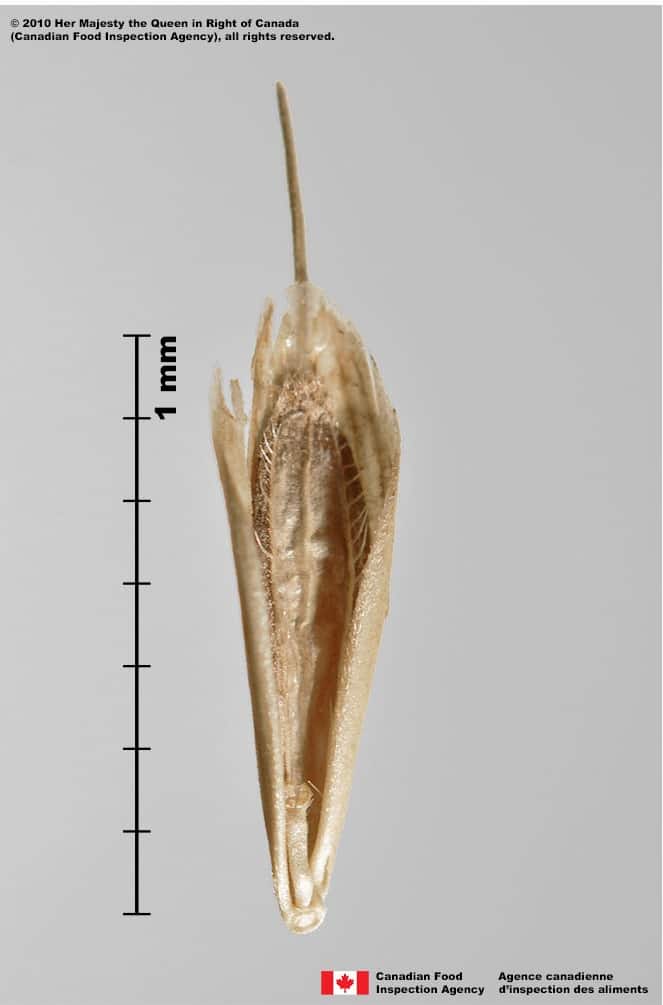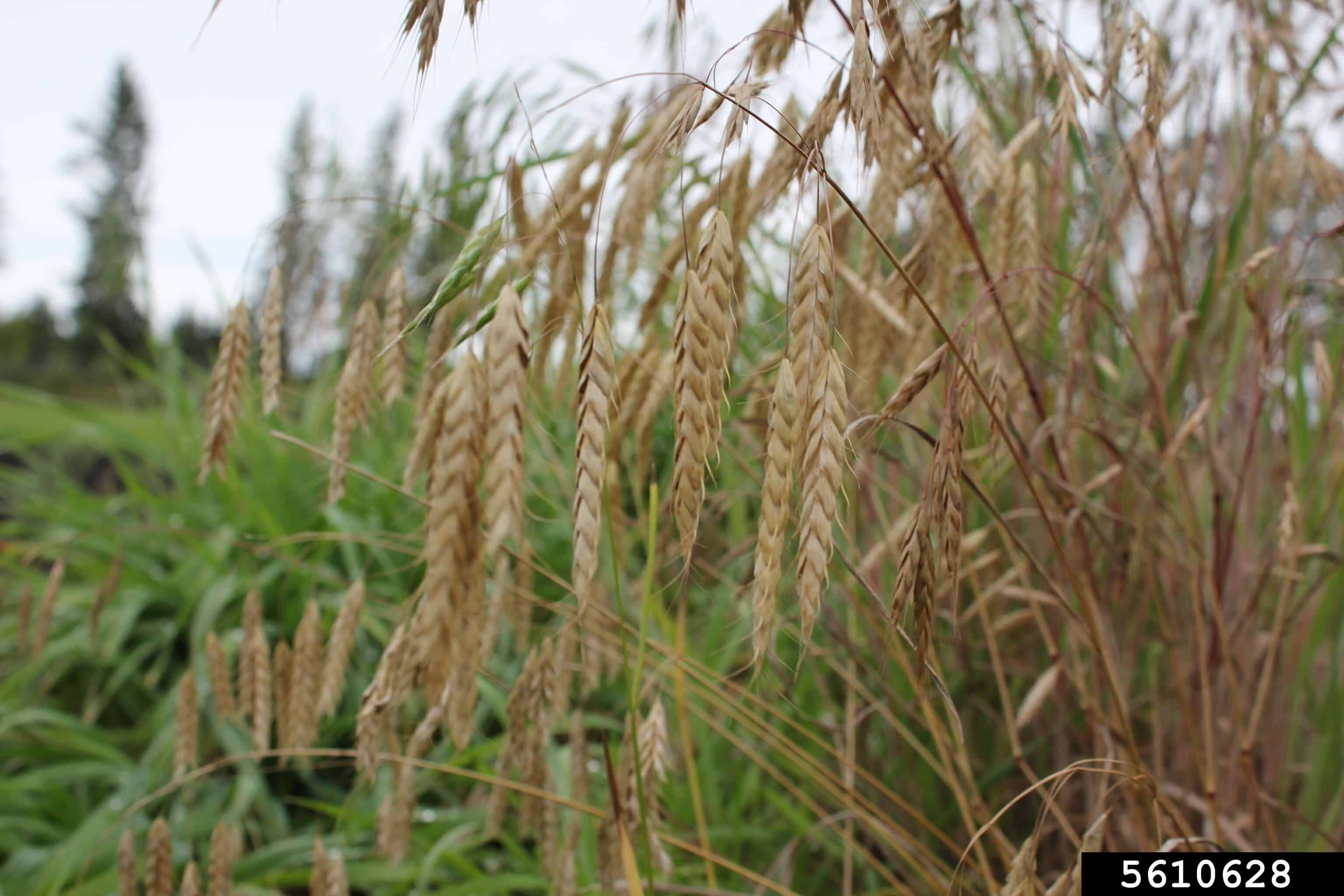Bromus japonicus
Overview
Aperçu
Regulation :
Remarques Réglementation:
- CFIA Weed Seeds Order - Class 3: Secondary Noxious Weed Seeds
Regulation Notes:
Distribution :
Répartition :
Native to northern Africa and temperate Eurasia from France eastward to China, Japan and Korea (USDA-ARS 2021). Introduced in parts of Europe, Australia, New Zealand, South Africa and North and South America (Holm et al. 1991; USDA-ARS 2021). Occurs throughout most of the United States (Barkworth et al. 2007), in the Yukon Territory and all Canadian provinces except Newfoundland and Prince Edward Island (Brouillet et al. 2010+).
Habitat and Crop Association :
Habitat et Cultures Associées :
Cultivated fields, old fields, rangelands, pastures, hay fields, gardens, roadsides, industrial sites and disturbed areas (Darbyshire 2003; Barkworth et al. 2007). A weed of Triticum aestivum subsp. aestivum (common wheat), Poaceae species (grasses) and Medicago sativa (alfalfa) seed fields, pastures and ranges, and many other places (Finnerty and Klingman 1962). Prefers somewhat moister habitats than B. tectorum (Kirkland and Brenzil 2007).
Economic Use, cultivation area, and Weed Association :
Utilisation économique, zone de culture et association de mauvaises herbes :
Duration of Life Cycle :
Durée du cycle vital:
Annual
Dispersal Unit Type :
Type d’unité de dispersion :
Floret
General Information
RENSEIGNEMENTS GÉNÉRAUX
Bromus japonicus can invade pastures and rangelands where it competes with native species, but can be used as an early-season forage (Howard 1994). It has been observed to increase in natural areas under a fire-suppression management regime (Howard 1994).
In Canada, annual Bromus species are often an indicator of poor range condition, and readily infest areas where native vegetation has been disturbed by overgrazing, fire, and cultivation (Kirkland and Brenzil 2007). B. japonicus occurs as a contaminant in seed and grain (USDA-ARS 2021).
.
Bromus japonicus (Sarah Schumacher, Bugwood.org)
Identification
Identification
-
Spikelet
Size
- Spikelet length 20.0 – 40.0 mm (Barkworth et al. 2007)
Shape
- Long oval-shaped spikelet, cylindrical or compressed in edge view
Surface Texture
- Spikelet smooth or scabrous with several longitudinal nerves
Colour
- Spikelet dull or shiny straw yellow
Other Features
- 6 – 12 florets in a spikelet (Barkworth et al. 2007)
-
Floret
Size
- Floret length* 7.1 – 9.2: mm; width: 1.3 – 1.7 mm
*Note: minimum and maximum of 10 florets in a normal range of this species using image measurement (ISMA 2020)
Shape
- Long oval-shaped floret, strongly compressed in edge view
Surface Texture
- Lemma scabrous with several longitudinal nerves
Colour
- Floret is dull or shiny straw yellow
Other Features
Lemma awn
- Top of lemma splits into 2 pointed lobes, awn arises between them and bends away from lemma
- Awn length: 8.0 – 13.0 mm (Barkworth et al. 2007)
Callus and Rachilla
- Rachilla end is flat with a brown circular scar
- Rachilla is short hairy and curved towards the palea
Other features
- Sides of lemma extend 0.3 – 0.6 mm past the palea on either side of the floret (Barkworth et al. 2007), often broken during processing
- Palea thin, can generally see the caryopsis behind it
- Palea teeth are long, thin and widely spaced
- The palea edges may extend beyond the palea teeth onto the caryopsis and are transparent with dense short hairs
- Palea is generally shorter than lemma

Japanese brome (Bromus japonicus); florets






-
Caryopsis
Size
- Caryopsis length*: 6.0 – 6.5 mm; width: 1.5 – 1.8 mm
*Note: minimum and maximum of 5 caryopses in a normal range of this species using specimen measurement (ISMA 2020)
Shape
- Caryopsis is long oval shaped, generally flat in edge view, some may have edges curled towards the middle
Surface Texture
- Caryopsis is a smooth texture
Colour
Caryopsis is reddish coloured
Other Features
- Caryopsis is generally as long as the palea
- A linear, black coloured hilum extends the length of the caryopsis

Bromus japonicus

-
Embryo
Size
- Embryo is a rudimentary size compared to the caryopsis
Shape
- Embryo is oval or wedge-shaped and located at an end of one flat side of the caryopsis
Endosperm
- Endosperm is hard and opaque white coloured
Identification Tips
CONSEILS POUR L’IDENTIFICATION
The florets of Bromus japonicus are similar to other Bromus species with a thin caryopsis and long palea teeth such as B. arvensis and B. hordeaceus. The florets of B. japonicus generally have a flat caryopsis, small hairs between the palea edge and the caryopsis edge, palea shorter than the lemma (often same length as caryopsis), and an awn that bends away from the lemma. B. hordeaceus florets do not have hairs between the palea and the edge of the caryopsis, and B. arvensis generally has a curled caryopsis, straight awn and a palea as long as the lemma.

Bromus japonicus








Additional Botany Information
AUTRES RENSEIGNEMENTS BOTANIQUES

Bromus japonicus (Sarah Schumacher, Bugwood.org)



Similar Species
ESPÈCES SEMBLABLES
Similar species are based on a study of seed morphology of various species, and those with similar dispersal units are identified. The study is limited by physical specimen and literature availability at the time of examination, and possibly impacted by the subjectivity of the authors based on their knowledge and experience. Providing similar species information for seed identification is to make users aware of similarities that could possibly result in misidentification.
Bromus hordeaceus L. (soft chess)
The florets of B. hordeaceus are generally smaller (length*: 5.5 – 7.8 mm; width: 1.3 – 2.3 mm). B. hordeaceus lemmas are hairy or smooth, generally more flexible with a shorter awn (6.0 – 8.0 mm; Barkworth et al. 2007) compared to B. japonicus. The palea is not hairy between the palea edge and the edge of the caryopsis.
Bromus arvensis L. (field brome)
The florets of B. arvensis are a similar size (length*: 7.5 – 9.1 mm; width: 1.3 – 2.0 mm) as B. japonicus with a shorter, straight awn (6.0 – 11.0 mm; Barkworth et al. 2007) that does not bend away from the lemma. The palea and the lemma are a similar length, and generally extend past the caryopsis end compared to the shorter palea of B. japonicus. The caryopsis edges are generally curled.
*Note: minimum and maximum of 10 florets in a normal range of this species using image measurement (ISMA 2020)
Click to select species
Cliquez pour sélectionner les espèces

Bromus arvensis

Bromus hordeaceus
Comparison Window
Fenêtre de comparaison
MAIN SPECIES
ESPÈCES PRINCIPALES
Bromus japonicus

Bromus japonicus
Poaceae
Japanese brome (Bromus japonicus); florets
MAIN SPECIES
ESPÈCES PRINCIPALES
Bromus japonicus

Bromus japonicus
Poaceae
Japanese brome (Bromus japonicus); floret
MAIN SPECIES
ESPÈCES PRINCIPALES
Bromus japonicus

Bromus japonicus
Poaceae
Bromus japonicus
MAIN SPECIES
ESPÈCES PRINCIPALES
Bromus japonicus

Bromus japonicus
Poaceae
Bromus japonicus
MAIN SPECIES
ESPÈCES PRINCIPALES
Bromus japonicus

Bromus japonicus
Poaceae
Bromus japonicus
MAIN SPECIES
ESPÈCES PRINCIPALES
Bromus japonicus

Bromus japonicus
Poaceae
Japanese brome (Bromus japonicus) floret; palea teeth
MAIN SPECIES
ESPÈCES PRINCIPALES
Bromus japonicus

Bromus japonicus
Poaceae
Bromus japonicus
SIMILAR SPECIES
ESPÈCES SEMBLABLES
Bromus arvensis

Bromus arvensis
Poaceae
Field brome (Bromus arvensis) florets
SIMILAR SPECIES
ESPÈCES SEMBLABLES
Bromus arvensis

Bromus arvensis
Poaceae
Field brome (Bromus arvensis) floret
SIMILAR SPECIES
ESPÈCES SEMBLABLES
Bromus arvensis

Bromus arvensis
Poaceae
Field brome (Bromus arvensis) palea teeth
SIMILAR SPECIES
ESPÈCES SEMBLABLES
Bromus arvensis

Bromus arvensis
Poaceae
Field brome (Bromus arvensis) extended lemma sides
SIMILAR SPECIES
ESPÈCES SEMBLABLES
Bromus arvensis

Bromus arvensis
Poaceae
Field brome (Bromus arvensis) florets
SIMILAR SPECIES
ESPÈCES SEMBLABLES
Bromus arvensis

Bromus arvensis
Poaceae
Bromus arvensis
SIMILAR SPECIES
ESPÈCES SEMBLABLES
Bromus arvensis

Bromus arvensis
Poaceae
Bromus arvensis
SIMILAR SPECIES
ESPÈCES SEMBLABLES
Bromus arvensis

Bromus arvensis
Poaceae
Bromus arvensis
Need ID Help?
Besoin d’aide pour l’identification?
Reference(s)
Référence(s)
Adamczewski, K., Kaczmarek, S., Kierzek, R. and Urban, M. 2015. Germination biology and weed thresholds of rye brome (Bromus secalinus L.) in wheat (Triticum aestivum L.). Pakistan Journal of Agricultural Science 52: 989-995.
Barkworth, M. E., Capels, K. M., Long, S., Anderton, L. K. and Piep, M. B., (eds.) 2007. Volume 24. Magnoliophyta: Commelinidae (in part): Poaceae, part 1. Oxford University Press, New York, New York.
Brouillet, L., Coursol, F., Meades, S. J., Favreau, M., Anions, M., Bélisle, P. and Desmet, P. 2010+. VASCAN, the database of vascular plants of Canada. http://data.canadensys.net/vascan/ Accessed March 03, 2021.
Centre for Agriculture and Bioscience International (CABI). 2021. Invasive Species Compendium, CAB International, Wallingford, UK. https://www.cabidigitallibrary.org/journal/cabicompendium Accessed March 03, 2021.
Darbyshire, S. J. 2003. Inventory of Canadian Agricultural Weeds. Agriculture and Agri-Food Canada, Research Branch. Ottawa, ON.
Davis, L. W. 1993. Weed Seeds of the Great Plains: A Handbook for Identification. University Press of Kansas, Lawrence, Kansas.
Georgia, A. E. 2007. A Manual Of Weeds: With Descriptions Of All The Most Pernicious And Troublesome Plants In The United States And Canada; Their Habits Of Growth And Distribution, With Methods Of Control. Kessinger Publishing.
Government of Canada (GC). 2016. Canadian Weed Seeds Order. https://laws-lois.justice.gc.ca/eng/regulations/SOR-2016-93/page-2.html (English) https://laws-lois.justice.gc.ca/fra/reglements/DORS-2016-93/page-2.html (French)
Holm, L. G., Pancho, J. V., Herberger, J. P. and Plucknett, D. L. 1991. A Geographical Atlas of World Weeds. Krieger Publishing Company, Malabar, Florida.
International Seed Morphology Association (ISMA). 2020. Method for Seed Size Measurement. Version 1.0. ISMA Publication Guide.
Stone, A. E., Peeper, T. F. and Solie, J. B. 2001. Cheat (Bromus secalinus) control with herbicides applied to mature seeds. Weed Technology 15 (2): 382-386.
U.S. Department of Agriculture-Agricultural Research Services (USDA-ARS). 2021. Germplasm Resources Information Network (GRIN), https://npgsweb.ars-grin.gov/gringlobal/taxon/taxonomysimple.aspx Accessed March 3, 2021.
Whitson, T. D., Burrill, L. C., Dewey, S. A., Cudney, D. W., Nelson, B. E., Lee, R. D. and Parker, R. 1992. Weeds of the West. Western Society of Weed Science, Jackson, Wyoming.
Wilson, P. and King, M. 2003. Arable Plants: A Field Guide. The Hanway Press, London, UK.




